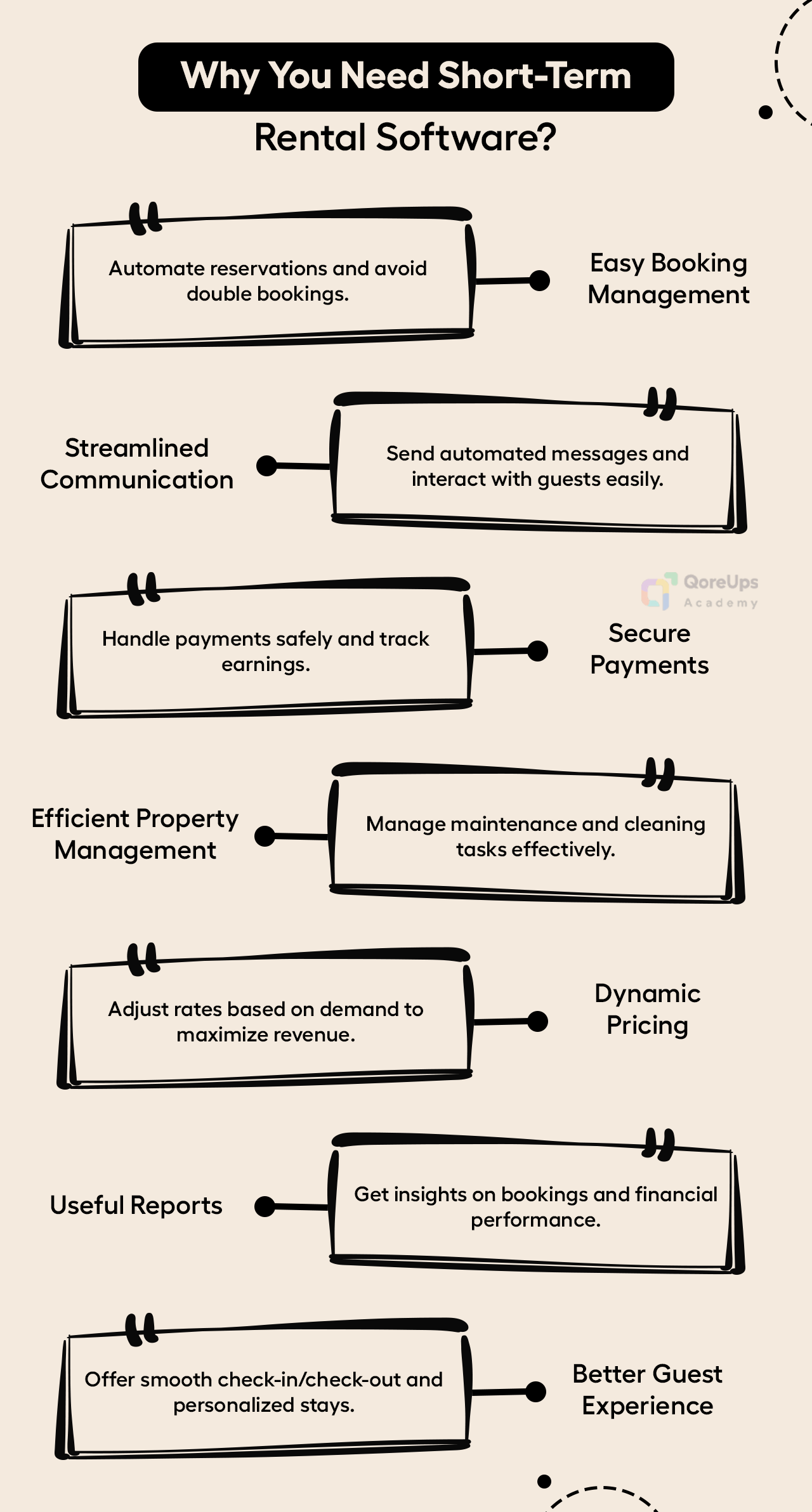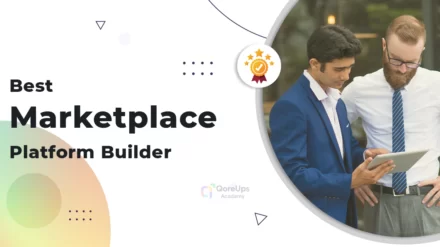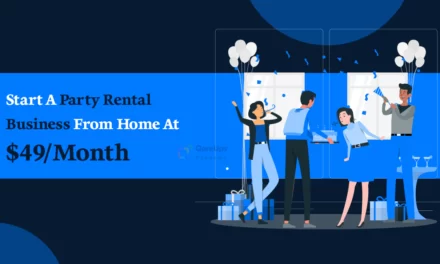Short term rentals are beginning to gain popularity over conventional hotels among tourists. These rentals provide unique lodging options and flexible booking policies.
The popularity of short term rentals has increased dramatically in recent years, thanks to the growth of websites like Booking.com, Airbnb, and VRBO.
These platforms offer a practical marketplace where renters look for lodging based on their needs and preferences and property owners may list their properties for rent.
Short term rentals encompass a wide range of properties, including apartments, houses, condominiums, villas, and even unique accommodations such as treehouses, yurts, and tiny houses.
This diversity of options allows travelers to find accommodations that suit their preferences, whether they’re looking for a cozy urban apartment, a beachfront villa, or a rustic countryside retreat.
Importance of Short Term Rental Software
Technology plays a major role in streamlining your business operations and enhancing your customer experience.
Short term rental software serves as a critical tool for property owners, property managers, and guests. This facilitates seamless booking processes, efficient property management, and enhanced communication channels.
Short term rental software automates many aspects of the rental process, allowing property owners and managers to streamline operations. Also, reduce administrative overhead, and focus on delivering exceptional guest experiences.
From property listing management to booking management, communication tools, and reporting and analytics, short term rental software provides a comprehensive solution for managing rental properties effectively.
Why Do You Need Short Term Rental Software?
Running a short term rental business comes with its own set of challenges, from managing bookings to ensuring that guests have a seamless experience.
Short term rental software is designed to simplify these processes, allowing property owners to maximize revenue while minimizing time spent on administrative tasks.
Let’s see why investing in short term rental software can transform your rental business.
Easy Booking Management
Managing reservations manually can lead to double bookings, missed opportunities, or other costly mistakes.
Short term rental software automates the booking process, ensuring that your calendar is up-to-date across multiple platforms and avoiding any overlap.
With an efficient system in place, you’ll spend less time on bookings and more time enhancing your business.
Streamlined Communication
Communication is key to a successful rental business.
Short term rental software helps you stay in touch with your guests by sending automated messages at key points in their journey—confirmations, check-in instructions, reminders, and post-stay reviews.
You can maintain a professional yet personalized touch without the need for constant manual involvement.
Secure Payments
Handling payments can be tricky, especially when dealing with multiple bookings.
The software provides secure payment gateways that ensure both you and your guests have peace of mind. It also allows you to track payments easily, giving you a clear view of your earnings.
Efficient Property Management
Maintaining your property between guest stays is vital for keeping it in top condition. With short term rental software, you can automate maintenance and cleaning tasks.
You can assign tasks, schedule them, and track completion all from one platform, ensuring that your property is always guest-ready.
Dynamic Pricing
Demand for short term rentals fluctuates based on seasons, events, and local market trends.
Dynamic pricing features in short term rental software allow you to adjust your rates automatically, maximizing revenue during high-demand periods while staying competitive during slower times.
Useful Reports
Making informed decisions is critical to running a profitable rental business.
Short term rental software provides insights into booking trends, financial performance, occupancy rates, and guest reviews.
With easy-to-digest reports, you can track your performance and identify areas for improvement.
Better Guest Experience
Enhancing the guest experience is crucial for attracting repeat visitors and positive reviews.
The software enables smooth check-ins and check-outs, offers contactless options, and provides personalized experiences based on guest preferences.
Happy guests lead to better reviews and, ultimately, higher occupancy rates.

Differences Between Mid Term, Long Term And Short Term
When managing rental properties, it’s important to know the differences between short-term, mid-term, and long-term rentals. Each has its own benefits and challenges, depending on what you’re looking to achieve.
Short-Term Rentals
Short-term rentals are usually rented for less than 30 days. These are popular for vacationers or business travelers who need a place for a short stay.
The main advantage of short-term rentals is the higher nightly rate, meaning more income in a shorter time. However, this type of rental requires constant attention since guests are coming and going frequently.
The property needs to be fully furnished and ready for guests at any time. Utilities are often included in the price, and owners or property managers handle most of the management work.
Mid-Term Rentals
Mid-term rentals are typically rented for 1 to 6 months. They are often used by corporate employees, students, or people temporarily relocating.
These rentals can also be furnished, but not always to the same level as short-term rentals.
The income is usually moderately higher than long-term rentals but lower than short-term rentals. The demand for mid-term rentals is more niche, but it can offer a good balance between turnover and stability for property owners.
Long-Term Rentals
Long-term rentals are rented for 6 months or more, usually with a lease agreement of a year or longer. Tenants in long-term rentals are looking for a permanent residence, and properties are typically not furnished.
The rental income is lower compared to short-term or mid-term rentals, but it offers consistent, steady income without the hassle of frequent turnover.
Utilities are often paid by the tenant, and the lease agreement is more formal, outlining all responsibilities for both the tenant and landlord.
Each type of rental serves a different purpose.
- Short-term rentals are best for higher, quick profits but require more work.
- Mid-term rentals are a middle ground, providing decent income with less turnover.
- Long-term rentals offer the most stability with a steady, reliable income.
Choose the one that best fits your goals and market.

8 Steps To Build Short Term Rental Software
Developing a robust short term rental software solution demands meticulous planning, strategic decision-making, and precise execution.
Below is an in-depth exploration of each step involved in creating such a platform:
Market Research
Conducting comprehensive market research is the foundation of any successful short term rental management software development project.
Start by understanding the needs, pain points, and preferences of key stakeholders in the short term rental industry. Also, include property owners, property managers, and guests.
Dive deep into market trends, competitor offerings, and emerging opportunities to gain valuable insights.
By gathering data on user behavior, market demand, and industry dynamics, you can identify gaps in the market. Also, you can define a clear direction for your software solution.
Define Requirements
Armed with insights from market research, it’s time to define the requirements for your short term rental software.
Identify the core features and functionalities that your platform must incorporate to address the needs of users effectively.
Also, prioritize features that solve critical pain points and deliver tangible value to property owners, property managers, and guests.
From property listing management and booking functionality to communication tools and reporting capabilities, ensure your software solution is comprehensive and user-friendly.
Choose Development Approach
Selecting the right development approach is crucial for the success of your project.
Consider factors such as budget, timeline, technical expertise, and scalability when choosing between building the short term rental management software from scratch, leveraging existing frameworks or platforms, or adopting a hybrid approach.
Each approach has its advantages and challenges, so weigh your options carefully to determine the most suitable path forward.
Whether you opt for custom development or utilize a go-to marketplace, prioritize flexibility, scalability, and maintainability to future-proof your software solution.
Develop Minimum Viable Product (MVP)
Building a Minimum Viable Platform (MVP) is a crucial step in the development process. It allows you to validate your idea and test key assumptions with real users.
Start by focusing on essential features such as property listing management, booking functionality, and basic communication tools.
Develop a functional prototype that demonstrates the core value proposition of your software. And provides a solid foundation for future iterations.
By prioritizing simplicity and usability, you can quickly iterate and refine your MVP based on user feedback and market validation.
Iterative Development
Embrace an iterative development approach to continuously improve your online rental software solution based on user feedback and market insights.
Engage with users early and often to gather valuable input that informs your development roadmap.
Prioritize feedback-driven enhancements that align with user needs and market demands, iterating on your software iteratively to enhance usability, performance, and functionality.
By adopting an agile mindset and remaining adaptable to change, you can ensure that your software evolves in line with evolving user expectations and industry trends.
Integrate Key APIs
Integrating with essential third-party APIs and services is essential for enhancing the functionality and connectivity of your software platform.
Key integrations may include payment gateways like PayPal, Stripe, etc, messaging platforms, property management systems, and channel managers.
By seamlessly integrating with external services, you can provide users with a seamless experience. Find additional capabilities that add value to your short term rental management software solution.
Prioritize security, reliability, and compatibility when selecting and integrating APIs, ensuring that your platform operates smoothly and securely.
Thorough Testing
Conducting comprehensive testing is critical to ensuring the quality, reliability, and security of your short term rental software platform.
Test across all aspects of the short term rental business software, including functionality, security, usability, and performance. This helps you to identify and address any issues or bugs before deployment.
Utilize a combination of automated and manual testing tools to thoroughly evaluate your software solution from end to end.
By prioritizing testing throughout the development process, you can minimize the risk of critical issues impacting the user experience and ensure a smooth launch.
Launch and Market
Once testing is complete, it’s time to launch your short term rental software platform to the market.
Implement targeted marketing strategies to attract property owners, property managers, and guests. Also, leverage digital marketing channels, social media platforms, and industry partnerships.
Highlight the unique value proposition of your software solution and emphasize its benefits to potential users.
Engage with your target audience through targeted advertising, content marketing, and community engagement to generate buzz and drive adoption.
Monitor user feedback and iterate on your marketing efforts to optimize performance and maximize your reach.

Essential Features and Functionality
When developing short term rental software, it’s essential to incorporate a range of features and functionalities to meet the diverse needs of users.
Below are the key features that every short term rental software platform should include:
- Property Listing Management: Enable property owners to create and manage property listings. This includes detailed descriptions, high-quality photos, availability calendars, and pricing information.
- Booking Management: Facilitate seamless booking experiences for guests. Allow them to search for properties, view availability, and make reservations directly through the platform.
- Calendar Synchronization: Implement calendar synchronization functionality to prevent double bookings and ensure accurate availability across multiple booking channels.
- Payment Processing: Integrate secure payment processing capabilities, supporting multiple payment methods and currencies, to facilitate seamless transactions between guests and property owners.
- Communication Tools: Provide robust communication tools, including messaging functionality and automated notifications, to enable seamless communication between guests and hosts throughout the booking process.
- Review and Rating System: Implement a review and rating system that allows guests to provide feedback and ratings on their stay, enhancing transparency and trust within the platform.
- Reservation Management: Streamline reservation management processes for property owners and managers, including check-in/check-out management, guest information management, and handling special requests.
- Channel Management: Integrate with external booking channels to maximize property exposure and bookings. Ensure seamless synchronization of property data across platforms.
- Reporting and Analytics: Provide comprehensive reporting and analytics capabilities. Allows property owners and managers to track key performance metrics, analyze booking trends, and make data-driven decisions.
- Maintenance Requests: Enable guests to submit maintenance requests directly through the platform, streamlining the resolution process for property owners and managers.
By incorporating these essential features and functionalities into your short term rental software platform, you can deliver a comprehensive solution.
Also, this helps you to meet the needs of property owners, property managers, and guests, driving business growth and enhancing profitability.
Top Short Term Rental Software In 2024
When it comes to managing short term rental properties, choosing the right software can make a significant difference in how smoothly your operations run.
As we move into 2024, several software platforms offer impressive features to streamline your rental business.
However, one platform stands out as particularly effective: QMarket.
QMarket has rapidly gained recognition for its user-friendly interface and comprehensive set of features tailored to short-term rental management.
It’s a favorite among property owners for its ease of use and robust capabilities.
Features:
- Dynamic Pricing: Automatically adjusts rental rates based on market demand, ensuring you maximize your revenue.
- Easy Integration: Seamlessly connects with multiple booking channels, reducing the hassle of managing reservations across various platforms.
- Automated Communication: Sends automatic messages for bookings, check-ins, and check-outs, improving the guest experience without requiring constant manual input.
- Detailed Reporting: Provides in-depth insights into your bookings, financial performance, and operational efficiency, helping you make informed decisions.
Why Choose QMarket?
QMarket excels because of its scalability and customization options. Whether you’re managing a few properties or a large portfolio, QMarket can be tailored to fit your needs.
Its ability to integrate with various booking channels and its advanced automation features make it an ideal choice for both small and large rental businesses.
Also, QMarket’s dynamic pricing and comprehensive reporting tools offer a significant advantage in maximizing revenue and managing your properties efficiently.
Conclusion,
So, building a successful short term rental software platform requires careful planning, strategic execution, and a deep understanding of market dynamics and user needs.
By following the steps outlined in this guide and incorporating essential features and functionalities, you can build short term rental software that revolutionizes the rental experience for property owners and guests alike.
To achieve long-term success in the competitive short term rental business, embrace innovation, iterate often, and put user satisfaction first.
Build Your Short Term Rental Software With QMarket!






